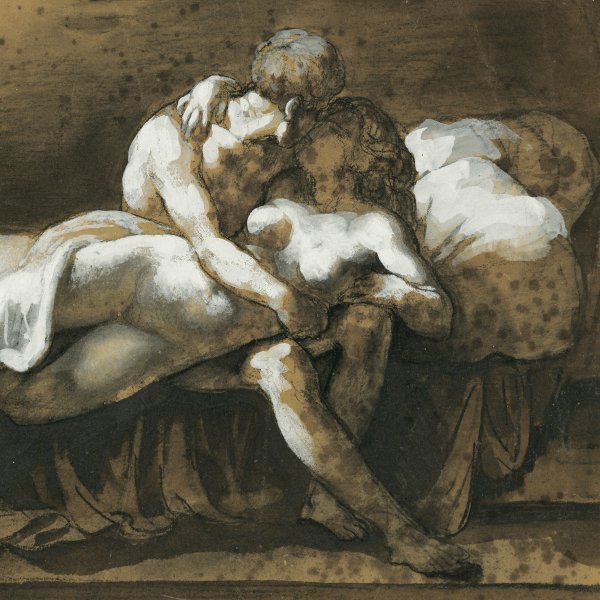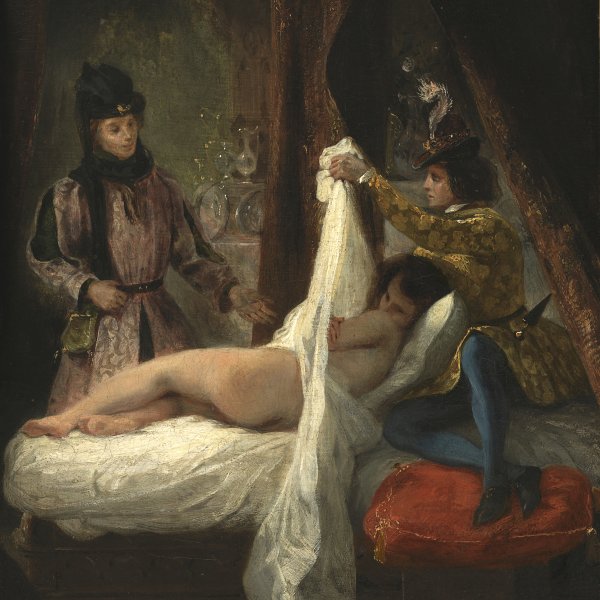Horse Race
ca. 1817
Oil on Paper mounted on canvas.
44 x 59 cm
Museo Nacional Thyssen-Bornemisza, Madrid
Inv. no.
157
(1979.40
)
ROOM 29
Level 2
Permanent Collection
Théodore Géricault was from a wealthy Rouen family that moved to Paris in 1796 for professional reasons. Géricault was not a particularly model pupil at school but showed an aptitude for drawing, particularly for depicting horses. In Paris he decided to take classes with Carle Vernet who specialised in equestrian subjects among others. Years later Géricault commented in relation to Vernet: “a single one of my horses would have devoured six of his”. In 1810 he was in the studio of Pierre Guérin where, due to his enthusiasm for colour (inspired by Rubens) and for his use of heavy impasto, he was known as “le pâtissier” or “le cuisinier de Rubens”. During this period Géricault regularly visited the Louvre in order to copy the works of the Old Masters. His interest in horses, which is evident throughout his oeuvre, was expressed not only in drawings but also in early paintings such as the one presented at the 1812 Salon entitled Officer of the Imperial Guard on Horseback, a large canvas for which he won a medal and which reflects the influence of Gros (Musée du Louvre). The composition was praised and Géricault was considered to be a fine painter of equestrian subjects. It depicts an officer on a prancing horse holding a sword and sitting in a somewhat artificial position. Two years later the artist presented another work of military inspiration at the Salon, entitled The wounded Cuirassier (also Musée du Louvre).
In 1816 Géricault decided to travel to Italy where he had originally intended to spend two years. He was in Florence in the October of that year and in Rome in November. In the latter city he saw the carnival in February 1817, and the races of stallions on the Corso known as the Corso dei Barberi. The artist was fascinated by this event and various studies and a large number of drawings have survived in which he depicted different moments of the races but which never became the subject of a definitive painting. The present study depicts an animated winning horse, its flanks covered by a green and gold cloth tied with its girth. The horse is energetically led by a stable boy holding up a yellow banner. Here Géricault depicts one of the last moments in the competition in which a young man, dressed in the traditional Roman manner, leads the winning horse in triumph around the course. Two drawings on this subject are also known: one in charcoal and the other in pencil, in the Musée des Beaux-Arts in Besançon and the Musée des Beaux-Arts in Orléans respectively. In the first the horse, its head adorned with trappings, is led by a youth who walks with a firm pace and turns his head to look at the animal. In the second the young man walks ahead of the horse, guiding it by its halter. The present composition entered the Thyssen-Bornemisza collection in 1979 from the US art market.
Mar Borobia
In 1816 Géricault decided to travel to Italy where he had originally intended to spend two years. He was in Florence in the October of that year and in Rome in November. In the latter city he saw the carnival in February 1817, and the races of stallions on the Corso known as the Corso dei Barberi. The artist was fascinated by this event and various studies and a large number of drawings have survived in which he depicted different moments of the races but which never became the subject of a definitive painting. The present study depicts an animated winning horse, its flanks covered by a green and gold cloth tied with its girth. The horse is energetically led by a stable boy holding up a yellow banner. Here Géricault depicts one of the last moments in the competition in which a young man, dressed in the traditional Roman manner, leads the winning horse in triumph around the course. Two drawings on this subject are also known: one in charcoal and the other in pencil, in the Musée des Beaux-Arts in Besançon and the Musée des Beaux-Arts in Orléans respectively. In the first the horse, its head adorned with trappings, is led by a youth who walks with a firm pace and turns his head to look at the animal. In the second the young man walks ahead of the horse, guiding it by its halter. The present composition entered the Thyssen-Bornemisza collection in 1979 from the US art market.
Mar Borobia









